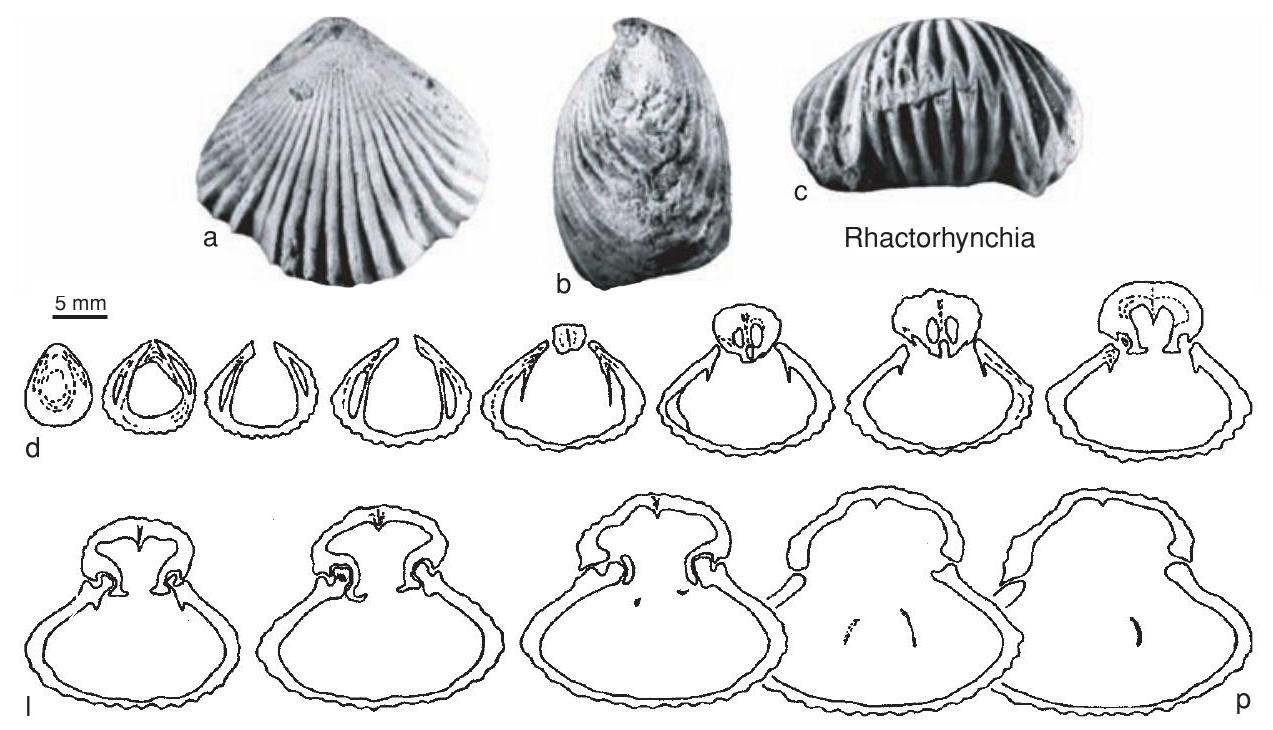Welcome to the Treatise on Invertebrate Paleontology!
Please enter a genera name to retrieve more information.

Rhactorhynchia
Classification
Phylum:
Brachiopoda
Subphylum:
Rhynchonelliformea
Class:
Rhynchonellata
Order:
Rhynchonellida
Superfamily:
Hemithiridoidea
Family:
Tetrarhynchiidae
Subfamily:
Kallirhynchiinae
Formal Genus Name and Reference:
Rhactorhynchia BUCKMAN, 1918, p. 50
Type Species:
R. rhacta, OD, =Rhynchonella subtetrahedra DAVIDSON, 1852b, p. 95, subj. [Species name was originally spelled subtetraëdra. Prevailing spelling adopted by BUCKMAN (1918, p. 226), preserved under Article 33.3.1 of ICZN (1999).]
Images
(Click to enlarge in a new window)
Fig. 922a-p. *R. subtetrahedra (Davidson), upper Bajocian, Cotswolds, England, a-c, dorsal, lateral, anterior views, USNM 88731, x1 (Shi & Grant, 1993), d-p, transverse serial sections, distances in mm from ventral umbo, 1.0, 1.8, 2.5, 3.7, 4.4, 5.2, 5.5, 6.2, 6.7, 7.5, 8.2, 9.1, 9.4, BUM 5029 (3) (new, courtesy of C. D. Prosser).
Synonyms
Rhactarhynchia
Geographic Distribution
England, France, ?Switzerland, ?Austria, ?Poland, ?Yugoslavia, Russia, Caucasus, ?Morocco, ?Israel, India, China, ?USA, ?Canada, ?Chile
Age Range
Beginning Stage in Treatise Usage:
Middle Jurassic (?Aalenian, Bajocian)
Beginning International Stage:
Aalenian
Fraction Up In Beginning Stage:
0
Beginning Date:
174.7
Ending Stage in Treatise Usage:
Middle Jurassic (Bathonian, ?Callovian), Upper Jurassic (?Oxfordian)
Ending International Stage:
Oxfordian
Fraction Up In Ending Stage:
100
Ending Date:
154.78
Description
Medium size to large, dorsibiconvex, oval to round subtrigonal, subglobose to globose, dorsal fold and ventral sulcus generally weak, sometimes asymmetrical, costae numerous, strong, sharp, beak strong, slightly incurved, foramen rimmed, hypothyrid, conjunct deltidial plates. Dorsal median septum strong, septalium brief, pitlike, crura raduliform, transitional to canaliform distally, muscle scars expanded.
References
Museum or Author Information
Classification
Phylum:
Brachiopoda
Subphylum:
Rhynchonelliformea
Class:
Rhynchonellata
Order:
Rhynchonellida
Superfamily:
Hemithiridoidea
Family:
Tetrarhynchiidae
Subfamily:
Kallirhynchiinae
Formal Genus Name and Reference:
Rhactorhynchia BUCKMAN, 1918, p. 50
Type Species:
R. rhacta, OD, =Rhynchonella subtetrahedra DAVIDSON, 1852b, p. 95, subj. [Species name was originally spelled subtetraëdra. Prevailing spelling adopted by BUCKMAN (1918, p. 226), preserved under Article 33.3.1 of ICZN (1999).]
Images
(Click to enlarge in a new window)
Fig. 922a-p. *R. subtetrahedra (Davidson), upper Bajocian, Cotswolds, England, a-c, dorsal, lateral, anterior views, USNM 88731, x1 (Shi & Grant, 1993), d-p, transverse serial sections, distances in mm from ventral umbo, 1.0, 1.8, 2.5, 3.7, 4.4, 5.2, 5.5, 6.2, 6.7, 7.5, 8.2, 9.1, 9.4, BUM 5029 (3) (new, courtesy of C. D. Prosser).
Synonyms
Rhactarhynchia
Geographic Distribution
England, France, ?Switzerland, ?Austria, ?Poland, ?Yugoslavia, Russia, Caucasus, ?Morocco, ?Israel, India, China, ?USA, ?Canada, ?Chile
Age Range
Beginning Stage in Treatise Usage:
Middle Jurassic (?Aalenian, Bajocian)
Beginning International Stage:
Aalenian
Fraction Up In Beginning Stage:
0
Beginning Date:
174.7
Ending Stage in Treatise Usage:
Middle Jurassic (Bathonian, ?Callovian), Upper Jurassic (?Oxfordian)
Ending International Stage:
Oxfordian
Fraction Up In Ending Stage:
100
Ending Date:
154.78
Description
Medium size to large, dorsibiconvex, oval to round subtrigonal, subglobose to globose, dorsal fold and ventral sulcus generally weak, sometimes asymmetrical, costae numerous, strong, sharp, beak strong, slightly incurved, foramen rimmed, hypothyrid, conjunct deltidial plates. Dorsal median septum strong, septalium brief, pitlike, crura raduliform, transitional to canaliform distally, muscle scars expanded.
